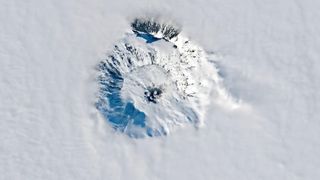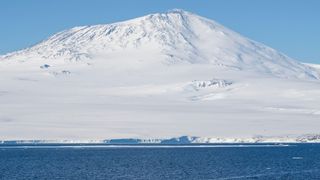
Antarctica is covered in volcanoes, could they erupt?
Antarctica's western ice sheet alone contains 138 volcanos.

Antarctica is perhaps best known for its endless expanse of ice and snow. But what many people don't realize is that hiding beneath its frosty facade are dozens of volcanoes.
In fact, under the continent's massive western ice sheet sits what is considered the largest volcanic region on Earth, with as many as 138 volcanoes. Of those volcanoes, 91 were first discovered as part of a 2017 study published in the journal Geological Society.
So, could any of Antarctica’s volcanoes erupt on the southernmost continent? For geologists, this question is both easy and hard, depending on the volcano.
While these volcanoes, which are surface expressions of heated material leaving Earth's interior, are considered young as far as volcanoes go, scientists were unable to "distinguish whether or not [they] are volcanically active," the study authors wrote.
Currently, there are only two volcanoes on the ice-covered continent that are classified as active: Deception Island, a horseshoe-shaped land mass north of mainland that's part of the South Shetland Islands; and Mount Erebus, the highest peak on the continent with a summit topping out at 12,448 feet (3,794 meters). It's considered the world's southernmost active volcano.
"Erebus, which looms over the McMurdo research base on Scott Island, has been continuously erupting since at least 1972," Conor Bacon, a postdoctoral research scientist at the Lamont-Doherty Earth Observatory at Columbia University in New York, told Live Science in an email.
Related: Where are most of the Earth's volcanoes?
Sign up for the Live Science daily newsletter now
Get the world’s most fascinating discoveries delivered straight to your inbox.
Since then, Mount Erebus has been known to "emit plumes of gas and steam" and even occasionally spew out rock "bombs," which collectively are known as strombolian eruptions, according to NASA Earth Observatory.
"One of its most interesting features is the persistent lava lake that occupies one of [its] summit craters, where molten material is present at the surface," Bacon said. "These are actually quite rare, as it requires some very specific conditions to be met to ensure the surface never freezes over."

Deception Island, on the other hand, is the caldera of an active volcano, which last erupted in 1970, according to the Deception Island Antarctic Specially Managed Area, which monitors the island for volcanic activity. (The island is currently classified as "green," with no eruption anticipated.)
Despite there being only two active volcanoes on the continent, Antarctica is speckled with fumaroles, volcanic vents that release gases and vapors into the air. If conditions are right, accumulation from these vents can create deposits known as fumarolic ice towers that reach heights of 10 feet (3 m).
Although scientists are constantly monitoring Antarctica's volcanoes with instruments, it can prove challenging to predict when exactly one might erupt next. In other words, besides the two active volcanoes and the various fumaroles, it's hard to say if any of the continent’s other volcanoes might erupt.
Mount Erebus and Deception Island alone only "have a small number of permanent monitoring instruments," Bacon said. "These networks primarily consist of seismometers to detect seismic activity associated with volcanic unrest. From time to time, researchers will deploy more extensive networks of instruments to conduct specific studies, but this naturally comes with a huge number of logistical challenges when compared to the many, far more accessible, volcanoes elsewhere in the world."
Another challenge awaits scientists, he added. "In addition to logistical challenges, the permanent installations need to be rugged enough to survive the harsh conditions and long polar nights," Bacon said.
Jennifer Nalewicki is former Live Science staff wrtier and Salt Lake City-based journalist whose work has been featured in The New York Times, Smithsonian Magazine, Scientific American, Popular Mechanics and more. She covers several science topics from planet Earth to paleontology and archaeology to health and culture. Prior to freelancing, Jennifer held an Editor role at Time Inc. Jennifer has a bachelor's degree in Journalism from The University of Texas at Austin.
Most Popular


